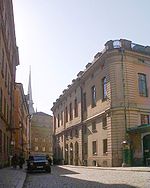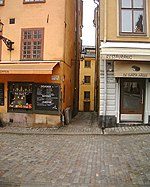Stortorget
Squares in StockholmStockholm Bloodbath

Stortorget (Swedish: [ˈstûːˌʈɔrjɛt], "the Grand Square") is a public square in Gamla Stan, the old town in central Stockholm, Sweden. It is the oldest square in Stockholm, the historical centre on which the medieval urban conglomeration gradually came into being. Today, the square is frequented by tens of thousands of tourists annually, and is occasionally the scene for demonstrations and performances. It is traditionally renowned for its annual Christmas market offering traditional handicrafts and food.
Excerpt from the Wikipedia article Stortorget (License: CC BY-SA 3.0, Authors, Images).Stortorget
Stortorget, Stockholm Gamla stan (Södermalms stadsdelsområde)
Geographical coordinates (GPS) Address External links Nearby Places Show on map
Geographical coordinates (GPS)
| Latitude | Longitude |
|---|---|
| N 59.325 ° | E 18.070833333333 ° |
Address
Stortorget
Stortorget
Stockholm, Gamla stan (Södermalms stadsdelsområde)
Sweden
Open on Google Maps











